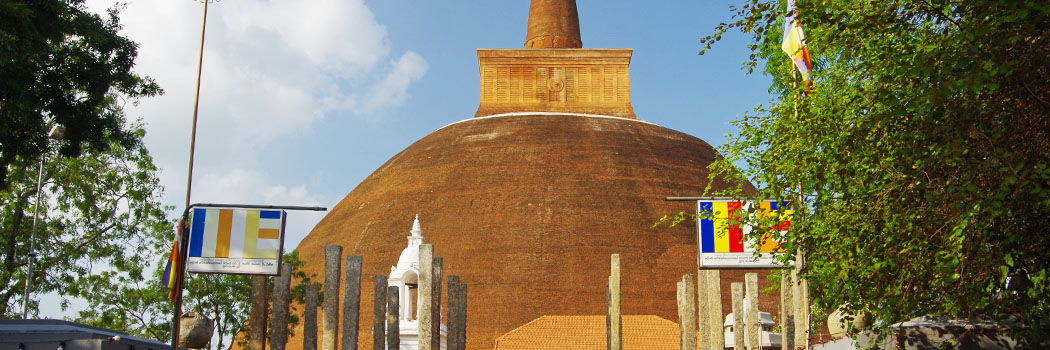
Situated in the Sacred City of Anuradhapura, Sri Lanka. It was one of the greatest monastic cities of the ancient world, 437 BC-845 AD, A World Heritage Site.
The third of Anuradhapura's great monasteries, Abhayagiri lies on the northern side of the city. The great monastery was founded by King Vatttagamani Abhaya (Valagambahu) (104-76 BC) in 88 BC.
Almost a Lost city in its self, Abhayagiri monastery is one of the most interesting & atmospheric quarters of Anuradhapura. The sheer scale of the ruins of the monastery is enormous; the setting, scattered amidst beautiful light woodland, is magical;
The Chinese traveller Buddhist bhikku (monk) Fa Hien, visiting Sri Lanka in the fifth century AD recorded that there were 5000 monks in residence. Bhikku Fa Hien also refers to a 7 meters jade Buddha statue, sparkling with gems situated within Abhayagiri grounds.
The story of Abhayagiriya;
Sri Lanka received the light of the Saddharma Pundarika Sutra (Lotus Sutra) many centuries before Japan, the flagship country that propagates the Lotus Sutra today. In the reign of King Valagambahu or even earlier this sect received royal patronage in Sri Lanka.
After King Valagambahu was defeated by an Indian invasion, the Monks of Abhayagiri blessed him and emboldened him to re-capture the country and gain sovereignty. In a grateful gesture for being blessed with the Buddha energy, through the monks of Abhayagiri Viharaya, which enable him to become the Sovereign of the country, the king built the Abhayagiri Viharaya to its pristine glory. From then onwards the Abhayagiri Viharaya received Royal Patronage.
The king gained courage and conviction for his prosperous and peaceful reign. The period in history. where so much prominence was given to Abhayagiri during the times of Mahasen and Valagambahu, was the period when the country was prosperous and self-sufficient. The prosperity of the country continued until the reign of king Mahasen up until the destruction of the Abhayagiri Viharaya. However, with the destruction of Abhayagiri Viharaya the prosperity of the country declined rapidly.
The great Abhayagiri Dagaba and monastery constructed by kind Valagambahu and offered to the theros stands even to date as a monument to this great heritage.
In "Ceylon History", a history book written by C. W. Nicholas and prof. Senarath Paranavithana, published by Oxford University, details are given about a dispute that occurred between Abhayagiri Vihara and Mahavihara during the reign of King Mahasen.
Abhayagiri Vihara is supposed to be built on a footprint of the Buddha. The Chinese traveler FaHien, who came to Sri Lanka in the 5th century, has said that there were 5000 monks in the Abhayagiri monastery.
The monks in Abhayagiri were supposed to be very graceful and pious. They used to venerate the book of the Lotus Sutra as the object of worship saying that they venerated the pure Dharma and the book was considered as the Dharma Datu.
Leaflets of the Saddharma Pundarika Sutra (The Lotus Sutra) written on gold sheets where found at Abhayagiriya premises during archeological excavations.
Also during recent excavations at historic sites, other than Abhayagiri including even Mihinthale, at the very spot where Buddhism was introduced to this country by Arahath Mahinda, gold and metal plates on which the Lotus Sutra was written have been discovered. These inscriptions were kept as objects of veneration and they were called Dhamma Dathu representing Dhamma kaya (the body of Dhamma of Thathagatha)
The Lotus Sutra was considered the Dharma Dathu and venerated. Monks of the Abhayagiri sect stated that this book is not supposed to be studied but only venerated as Dharma Dathu. I suppose this was because only Nicheren Diasonin could give us, the people of the latter day of the law, (that is this era) the essence of the Sutra and show us how to practice, he gave us the Dharani or the Gatha or Shadaswara Mantra. It was not born at that time. Now we know how to practice the Lotus Sutra.
The monks of Abhayagiri tried to preserve this for us, the laymen of the latter day. Unfortunately even the Abhayagiri Viharaya was destroyed.
Also, when the Tooth Relic was brought to Sri Lanka, King Kithsirimevan entrusted the Abhayagiri Viharaya with the custody and care of the Relic,
and in fact the first Dalada Perahara was conducted from the Abhayagiri Viharaya to the inner City of Anuradhapura.
Prof. T. G. Kulatunga of the Sri Jayawardhanapura University in his book "Anurapura Abhayagiri Viharaya" says that in 411 to 413 A. D.
* monks from China,
* King Gunawarna of Kashmir who was ordained at this Vihara,
* BikhuniDevasara who took the MeheniUpasampada tradition from Sri Lanka to China,
* Bikkhu Nanda who took a Buddha Statue to China
were all resident at the Abhayagiri Vihara;
which indicates the collaboration between Sri Lanka and other Buddhist countries in the region. The inscriptions found at this Vihara site are in Sanskrit, the international language of the India continent at that time; whereas the inscriptions found in other areas in the vicinity of Abhayagiriya are in old Sinhala.
The Abhayagiri Viharaya was a University of Buddhist studies of international repute at that time and was considered a branch of the Nalanda University of India. It was a center for International, Inter Religious Co-operation and many monks from Buddhist countries have visited this Viharaya during its heyday.
References:
(http://www.lankalibrary.com/heritage/abayagiri.htm)
(https://en.wikipedia.org/wiki/Abhayagiri_vih%C4%81ra)
(https://amazinglanka.com/wp/abayagiri-stupa/)